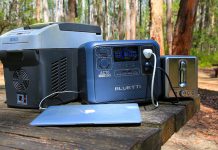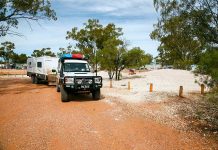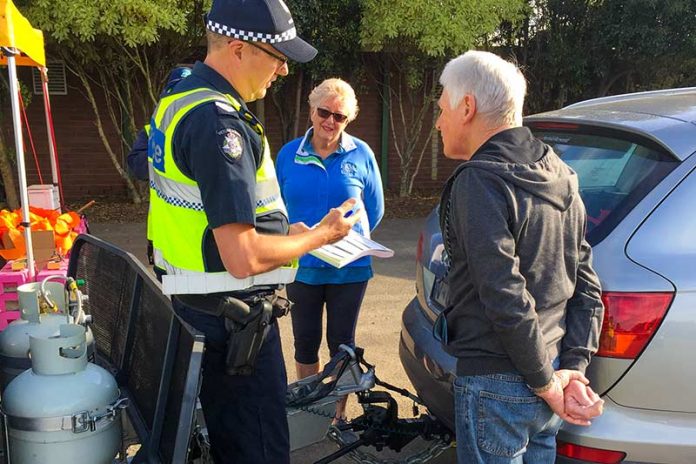
Do you know the road rules? You probably do know the laws that apply to driving a standard motor car but what about the rules that are aimed specifically at those of us towing our caravans? There are several rules that you’ve probably never heard of, let alone considered, that are specifically aimed at, or have particular relevance to, drivers towing caravans and other large trailers.
Here are seven road rules that you need to know about if you want to avoid a fine when towing a caravan.
ROAD AND TRAFFIC
You are required to have a clear view of the road and traffic. But you may be surprised to learn that there is no specific rule that states the need to fit towing mirrors; however, Road Rule 297 states:
A driver must not drive a motor vehicle unless the driver has a clear view of the road, and traffic, ahead, behind and to each side of the driver.
When you attach a caravan to the back of your car, the chances are that it will impede your vision behind and to the rear of both sides of your vehicle. The diagram below illustrates how this happens and how the fitment of extension mirrors overcomes this issue.
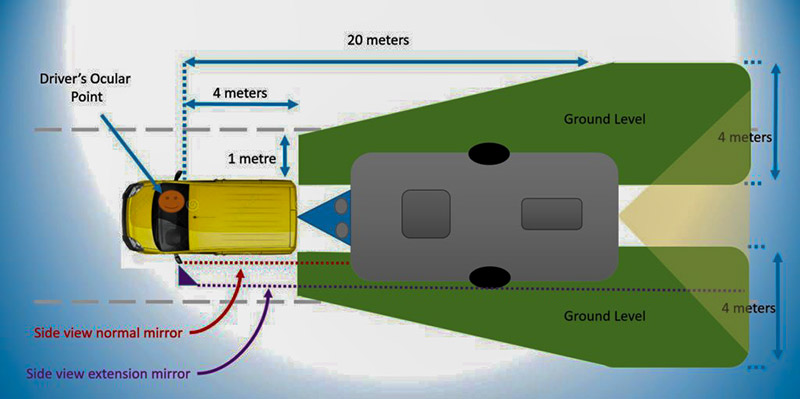
Now, I will admit that not everyone is going to find a large area to measure out all these distances but there is one specific test you can do to check that your mirrors are compliant. Measure the total width of your caravan and then measure the distance between the outside edges of your mirrors.
You’ll need to use a tape measure and open both front windows to make this second measurement. If the distance between your mirrors is less than the width of your caravan, you need to fit extension mirrors.
Keep in mind this rule also applies to your vision out the front of the car. You need to be very careful about where you place accessories like dash cams, camera monitors, GPS units, tyre pressure monitors and phone holders to ensure they do not impede your view of the road ahead.
OVERWEIGHT CARAVANS
If you’re a regular reader of GoRV, you would know that we often write about the need to be aware of the weight limits of your car and caravan; however, I don’t think we’ve ever mentioned the actual road rule that applies here. Road Rule 297-2 states:
A driver must not drive a motor vehicle that has a motor vehicle, trailer or other vehicle attached to it for the purpose of being towed if the laden weight of the towed vehicle exceeds:
a) The capacity of the towing attachment fitted to the towing vehicle; or
b) The maximum laden weight for the towed vehicle (ATM).
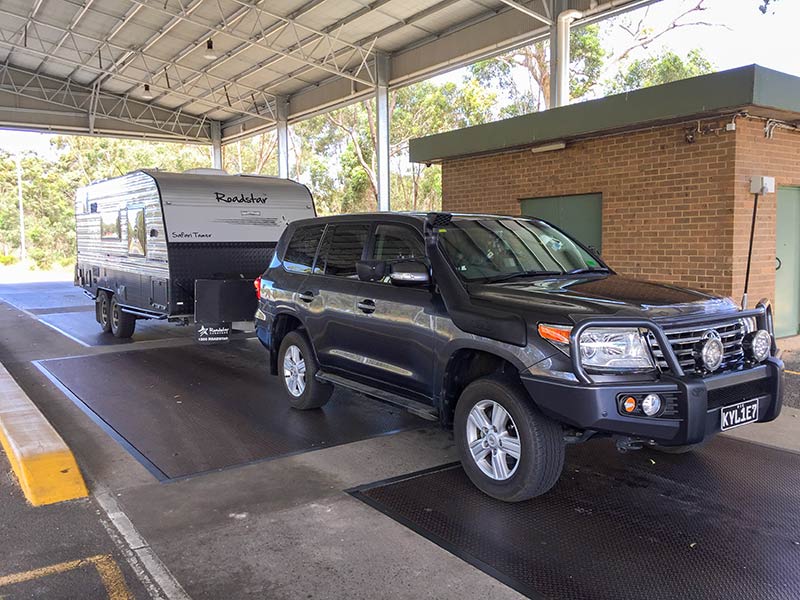
Now, I’ve only ever seen two cases where a driver towing a caravan was booked for infringing this rule, one being as a result of a fatal crash. But I have seen cases where a driver was booked towing an overweight tandem trailer with another car on it, and drivers towing overweight box trailers. This rule is enforced.
The issue of overweight caravans is only getting worse and road authorities are only too aware of this. It is just a matter of time before they start to book drivers for overweight caravans at roadside checks. If you want to ensure you’re not overweight, have your rig professionally weighed by a weighing service in your area.
SIGNAGE
This is an interesting one, as I reckon a lot of caravanners, new and experienced, are not aware that they might be entitled to fit a ‘Do Not Overtake Turning Vehicle’ sign. If the combined length of your car and caravan is 7.5m or more (that’s 24ft in the old language) and you need to straddle lanes or occupy an adjacent lane to turn at intersections. In that case, you must display a Do Not Overtake Turning Vehicle sign on the rear of your caravan.

Okay, I hear many of you saying your van is only 18 feet (5.4m). Well, consider most caravan lengths refer to the inside length and don’t take into account the drawbar. So your 18ft van could easily be 7m long on its own. Also, how long do you think your tow vehicle is? If you have a 200 Series Land Cruiser, it’s 4.95m while a Ford Ranger comes in at a whopping 5.4m. Both measurements are without any bull bars or tow bars fitted.
You may believe you can easily navigate tight turns without veering into an adjacent lane but consider that there may be a situation where you can’t. Having one of these signs gives you some legal protection should another driver bump into you while trying to overtake you.
My advice? Just fit one anyway if your combo fits the length requirements.
DRIVING TOO SLOWLY
I want to preface this by saying there is no legal requirement for any vehicle to travel at or above the speed limit. You must drive to the conditions and within the abilities of yourself and your vehicle. That said, you can, be booked for being an unreasonable obstruction to another driver or pedestrian. Regulation 125 states:
1. A driver must not unreasonably obstruct the path of another driver or a pedestrian.
2. For this rule, a driver does not unreasonably obstruct the path of another driver or a pedestrian only because –
a. The driver is stopped in traffic; or
b. The driver is driving more slowly than other vehicles (unless the driver is driving abnormally slow in the circumstances).
Example of a driver driving abnormally slow:
A driver driving at a speed of 20 kilometres per hour on a length of road to which a speed limit of 80 kilometres per hour applies when there is no reason for the driver to drive at that speed on the length of road.
Admittedly, you would have to be going pretty slow to be booked under this road rule but consider, in Queensland at least, if you are on a single-lane road and you’re holding up a long line of traffic behind you, you are required to pull over and allow those vehicles to pass you, as long as it is safe to do so.
DRIVING TOO FAST
In most states and territories in Australia, you can drive at the posted speed limit while towing your caravan. The two exceptions are New South Wales and Western Australia.

In NSW, the law states:
When towing a single trailer, the driver driving a vehicle, with a gross vehicle mass (GVM) over 4.5 tonnes or a vehicle and trailer combination with a gross combination mass (GCM) over 4.5 tonnes, must not exceed 100 km/h, regardless of the signed posted speed limit.
In Western Australia, all vehicles towing a trailer, regardless of weight, are restricted to a speed limit of 100km/h.
REGISTRATION PLATE PLACEMENT
Did you know there is a legal maximum height for placing a numberplate on your caravan? I know of at least one driver who was booked for this.
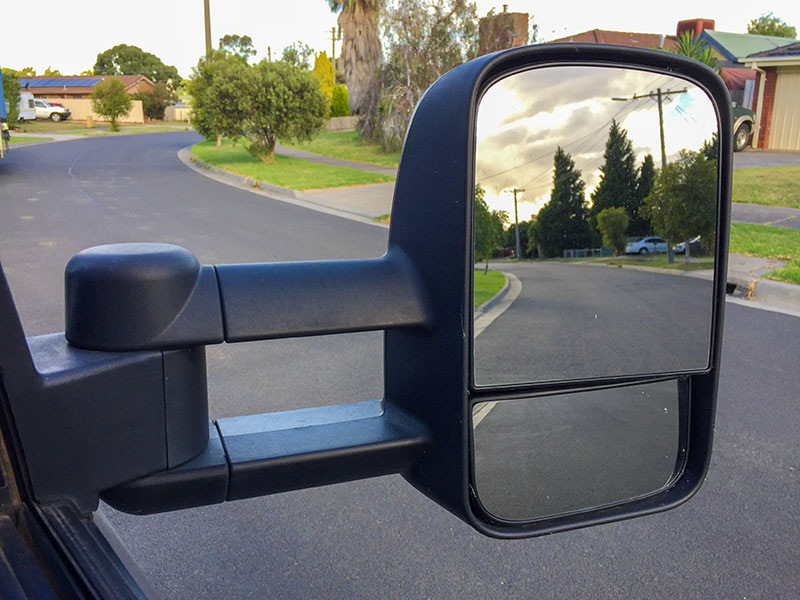
The Australian Design Rules (ADRs) 61/02 Vehicle Markings, Section 9.1.1.1 states:
…Provision must be made for mounting a registration plate to be affixed to the rear of the vehicle so that no part of such plate is more than 1300 mm from the ground.
If you buy a new caravan, this really shouldn’t be an issue. Still, if you’ve purchased a second-hand caravan, especially an offroad van, you should get out your tape measure and physically check the height of the numberplate to ensure it is less than 1.3m off the ground.
TOWING TWO TRAILERS AT ONCE
A few years ago, a bloke in Mildura, Vic, stunned the caravanning community when pictures of him appeared in the local paper towing a caravan and a boat behind his Toyota Land Cruiser. He claimed it was legal and had been signed off by an engineer. It sparked much debate about the legality of this arrangement that continues today.
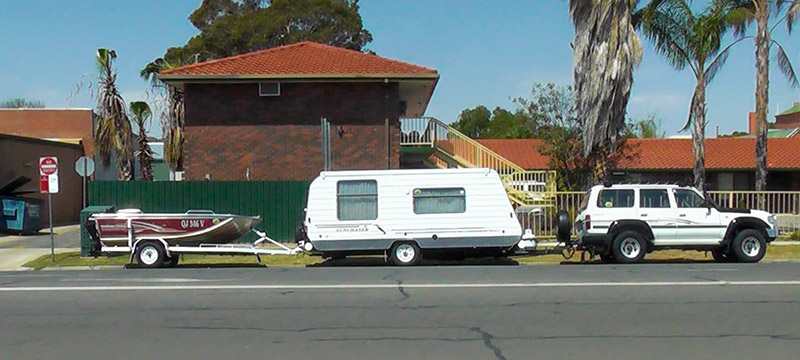
Unfortunately, the papers didn’t publish the events of the following days when Vic Roads contacted him and told him to dismantle his contraption as it was not legal in Victoria.
It doesn’t matter what you may get an engineer to sign off on. If it’s not legal, it’s not legal, and towing two trailers at one time behind a light vehicle is illegal in every state and territory of Australia.
Occasionally, you might see some pictures appear on social media of someone trying it on, claiming they can do it with a road train licence or other such nonsense. Ultimately, they are short-lived and taken off the road.
Think about it. If it was legal, there would be Facebook groups dedicated to it. There would be a process to get them registered through state road authorities and you would see these rigs everywhere. You don’t because it’s not legal.
ALWAYS CHECK LOCAL ROAD RULES
One last piece of advice I want to give you is to check the road rules in each state or territory you intend to travel in for any differences. Yes, we are supposed to have national road rules but these can sometimes vary between states and territories.
For example, the rules around U-turns are different in Victoria to those in Queensland, as I found out one night at a cost of $160 and one demerit point.
Safe travels.


